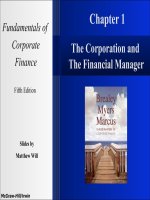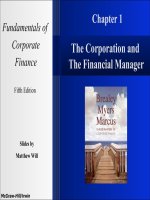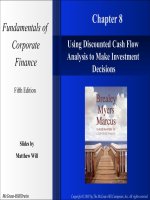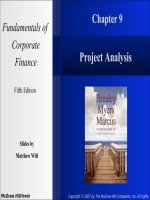Fundamentals of corporate finance 10e ROSS JORDAN chap011
Bạn đang xem bản rút gọn của tài liệu. Xem và tải ngay bản đầy đủ của tài liệu tại đây (991.66 KB, 55 trang )
Chapter 11
Project Analysis and
Evaluation
McGraw-Hill/Irwin
Copyright © 2013 by The McGraw-Hill Companies, Inc. All rights reserved.
Chapter Outline
• Evaluating NPV Estimates
• “Scenario” and other “What-if”
Analyses
• Break-Even Analysis
• Operating Cash Flow, Sales Volume,
and Break-Even
• Operating Leverage
• Capital Rationing
Chapter Outline
• Evaluating NPV Estimates
• “Scenario” and other “What-if”
Analyses
• Break-Even Analysis
• Operating Cash Flow, Sales Volume,
and Break-Even
• Operating Leverage
• Capital Rationing
Evaluating NPV Estimates
The future cash inflows for a NPV
computation is just an estimate
A positive NPV is a good start – now
we need to take a closer look:
Forecasting risk – how sensitive is our
NPV to changes in the cash flow
estimates; the more sensitive, the
greater the forecasting risk
Sources of value – why does this
project create value?
Chapter Outline
• Evaluating NPV Estimates
• “Scenario” and other “What-if”
Analyses
• Break-Even Analysis
• Operating Cash Flow, Sales Volume,
and Break-Even
• Operating Leverage
• Capital Rationing
Scenario Analysis
What happens to the NPV under different cash flow
scenarios?
At the very least, look at:
Best case – high revenues, low costs
Worst case – low revenues, high costs
Then measure the range of possible outcomes
Best case and worst case are not necessarily probable, but
they can still be possible
New Project Example
Consider the following project:
The initial cost is $200,000, and the project has a 5-
year life. There is no salvage. Depreciation is straightline, the required return is 12%, and the tax rate is
34%.
The base case NPV is $15,567
Summary of Example
Scenario Analysis
Scenari Net
o
Incom
e
Base
19,80
case
0
Worst
Case 15,51
0
Best
59,73
Case
0
Cash
Flow
NPV
IRR
59,80 15,567 15.1%
0
24,49
0
111,71 14.4%
9
99,73 159,50 40.9%
0
4
Sensitivity Analysis
What happens to NPV when we change one
variable at a time?
This is a subset of scenario analysis where we are
looking at the effect of specific variables on NPV
The greater the volatility in NPV in relation to a
specific variable, the larger the forecasting risk
associated with that variable, and the more
attention we want to pay to its estimation
Summary of Sensitivity
Analysis for a New
Project
Scenar
io
Base
case
Worst
case
Best
case
Unit Cash NPV
IRR
Sales Flow
6,000 59,80 15,56 15.1%
0
7
5,500 53,20
10.3%
0
8,226
6,500 66,40 39,35 19.7%
0
7
Simulation Analysis
Simulation is really just an expanded
sensitivity and scenario analysis
Monte Carlo simulation can estimate
thousands of possible outcomes based
on conditional probability
distributions and constraints for each
of the variables
Simulation Analysis
The output is a probability distribution
for NPV with an estimate of the
probability of obtaining a positive net
present value
The simulation only works as well as
the information that is entered, and
very bad decisions can be made if care
is not taken to analyze the interaction
between variables
Making a Decision
Beware of:
“Paralysis of
Analysis”!
At some point you
must make a
decision!
Making a Decision
If the majority of your scenarios have
positive NPVs, then you can feel
reasonably comfortable about accepting
the project
If you have a crucial variable that leads
to a negative NPV with a small change
in the estimates, then you may want to
forego the project
Chapter Outline
• Evaluating NPV Estimates
• “Scenario” and other “What-if”
Analyses
• Break-Even Analysis
• Operating Cash Flow, Sales Volume,
and Break-Even
• Operating Leverage
• Capital Rationing
Break-Even Analysis
A common tool for analyzing the relationship
between sales volume and profitability
There are three common break-even measures:
Accounting break-even:
sales volume at which NI = 0
Cash break-even:
sales volume at which OCF = 0
Financial break-even:
sales volume at which NPV = 0
Example: Costs
There are two types of costs that are important in
breakeven analysis: variable and fixed
Total variable costs =
quantity * cost per unit
Fixed costs are constant, regardless of output, over
some time period
Total costs = fixed + variable = FC + vQ
Example: Costs
Example:
Your firm pays $3,000 per month in fixed costs. You
also pay $15 per unit to produce your product.
What is your total cost if you produce 1,000
units?
What if you produce 5,000 units?
Average vs. Marginal
Cost
Average Cost
TC / # of units
Will decrease as # of units increases
Marginal Cost
The cost to produce one more unit
Same as variable cost per unit
Average vs. Marginal
Cost
Example: What is the average cost and marginal
cost under each situation in the previous example?
Produce 1,000 units:
Average = 18,000 / 1000 = $18
Marginal = $16
Produce 5,000 units:
Average = 78,000 / 5000 = $15.60
Marginal = $16
Three Types of BreakEven Analysis
1. Accounting Break-even
Where NI = 0
Q = (FC + D)/(P – v)
2. Cash Break-even
Where OCF = 0
Q = (FC + OCF)/(P – v) (ignoring taxes)
3. Financial Break-even
Where NPV = 0
Cash B-E < Accounting B-E < Financial B-E
1. Accounting Break-Even
The quantity that leads to a zero net
income.
NI = (Sales – VC – FC – D)(1 – T) =
0
QP – vQ – FC – D = 0
Q(P – v) = FC + D
Q = (FC + D) / (P – v)
Using Accounting BreakEven
Accounting break-even is often used as an early
stage screening number
If a project cannot break-even on an accounting
basis, then it is not going to be a worthwhile project
Accounting break-even gives managers an
indication of how a project will impact accounting
profit
Accounting Break-Even
and Cash Flow
We are more interested in cash flow than we are in
accounting numbers
As long as a firm has non-cash deductions, there will
be a positive cash flow
If a firm just breaks even on an accounting basis,
cash flow = depreciation
If a firm just breaks even on an accounting basis,
NPV will generally be < $0
Accounting B-E
Example
Consider the following project:
A new product requires an initial investment of $5
million and will be depreciated to an expected
salvage of zero over 5 years
The price of the new product is expected to be
$25,000, and the variable cost per unit is $15,000
The fixed cost is $1 million









